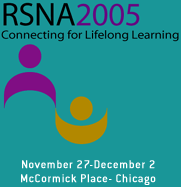
Abstract Archives of the RSNA, 2005
Walter Miguel Palm MD, Presenter: Nothing to Disclose
Jeroen Van Der Grond PhD, Abstract Co-Author: Nothing to Disclose
Olafur Kjartansson MD, Abstract Co-Author: Nothing to Disclose
Vilmundur Gudnason MD, PhD, Abstract Co-Author: Nothing to Disclose
Lenore J. Launer PhD, Abstract Co-Author: Nothing to Disclose
Mark A. Van Buchem MD, PhD, Abstract Co-Author: Nothing to Disclose
Normal Pressure Hydrocephalus (NPH) is a neurological syndrome that combines a clinical triad of gait impairment, cognitive impairment and urinary incontinence with normal cerebrospinal fluid pressure. One of the most important imaging signs associated with NPH is ventricular enlargement inconsistent with the degree of enlargement of the cortical sulci. The purpose of this study is to determine the distribution of disproportionate ventricular dilation in a general population of elderly subjects, and to study the association between disproportionate ventricular dilation and the three symptoms from the NPH clinical triad.
We recruited 858 subjects from the general population (427 male, age range 66-92 years). Gait was evaluated with a test of basic functional mobility. Cognition was assessed with a neuropsychological test battery. Bladder function was evaluated with a questionnaire. FLAIR, T2 and intermediate-weighted brain MRI scans were acquired at 1.5 T. Volumetric assessment was performed through semi-automated segmentation of ventricular and extraventricular cerebrospinal fluid (CSF) volumes. Ventricular volume was divided by extraventricular CSF volume (VV/EVV) to obtain a ratio quantifying disproportionate ventricular dilation. Linear regression analyses, adjusted for age and gender, were performed to study the association between VV/EVV and symptoms from the NPH clinical triad.
Mean VV/EVV was 0.16, ranging from 0.04 to 0.71. Increase in VV/EVV was correlated with a worse performance on the mobility test (r = 0.14, p < 0.001). There was no correlation between VV/EVV and cognitive test results. No correlation was found between VV/EVV and the presence of urinary incontinence.
There is a considerable range of VV/EVV values in the general population, indicating that ventricular enlargement out of proportion to the subarachnoid space is not exclusive to NPH patients. In elderly from the general population, disproportionate ventricular dilation is associated with gait impairment but not with cognitive decline or urinary incontinence. This suggests that factors other than a hydrodynamic CSF disorder are required for the development of a complete NPH clinical triad.
Palm, W,
Van Der Grond, J,
Kjartansson, O,
Gudnason, V,
Launer, L,
Van Buchem, M,
Disproportionate Ventricular Dilation in Elderly from the General Population: Distribution and Association with Normal Pressure Hydrocephalus Symptoms. Radiological Society of North America 2005 Scientific Assembly and Annual Meeting, November 27 - December 2, 2005 ,Chicago IL.
http://archive.rsna.org/2005/4407093.html

